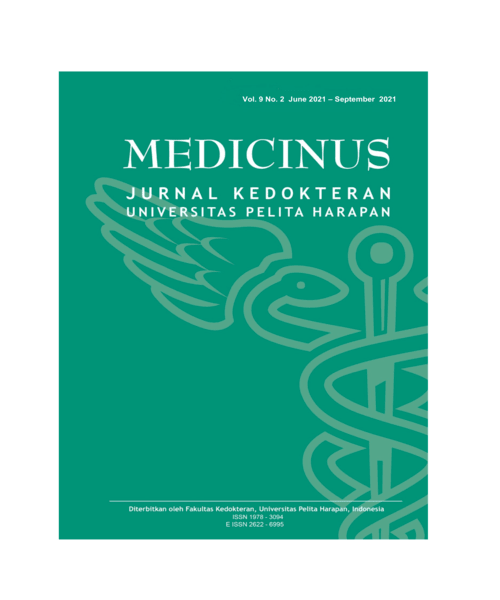Knowledge, Attitude and Behavior of Methodist 2 Palembang High School Student towards Clean and Healthy Lifestyle (PHBS)
DOI:
https://doi.org/10.19166/med.v9i2.4937Keywords:
Clean and Healthy Lifestyle, PHBS, knowledges, attitudes, behaviorAbstract
Background: Clean and Healthy Lifestyle or namely PHBS (Perilaku Hidup Bersih dan Sehat) in Indonesia is a program from the Indonesian Ministry of Health that has been implemented since 1996. PHBS in school settings is very important to be realized in order to create a clean and healthy school environment so that the learning and teaching process can run effectively.
Aims: This study aims to describe the knowledge, attitudes, and behavior of Methodist 2 High School students towards PHBS. In addition, this study also aims to see the relationship between PHBS knowledge and attitudes towards PHBS behavior in Methodist 2 Palembang High school students
Methods: This study uses a cross-sectional study involving 216 students obtained by calculating unpaired categorical analytic samples. Samples were taken using the purposive sampling technique. Data was collected using a questionnaire distributed online via a google form. The data obtained were processed using Chi-Square through the SPSS 25.
Results: There were 216 respondents who met the inclusion and exclusion criteria of this study. The sample consisting of female (n=124 (57.4%)) and male (n=92 (42.6%)) and distributed evenly from 1st grade to 3rd grade (1st grade n=65 (30.1%), 2nd grade n=75 (34.7%), 3rd grade n=76 (35.2%)). Using average value as cut-off point (12.7), most of the students of Methodist 2 Palembang high school had sufficient knowledge of PHBS (n=132 (61%), and the rest of it had insufficient knowledge of PHBS (n=84 (38,9%)). With a median value (57.6) as the cut-off point, it showed that most of the students had a sufficient PHBS attitude (n=118 (54.6%)) and the rest of it had an insufficient attitude of PHBS (n=98 (45,5%)). With an average value (13.2) as a cut-off point, most of the students had insufficient PHBS behavior (n=102 (52.8%)) and the rest of it had sufficient behavior of PHBS (n=102 (42,7%)). The results of the analysis found that there was no significant relationship between knowledge and PHBS behavior among Methodist 2 Palembang high school students (p-value = 0.744) and there was a significant relationship between PHBS attitudes towards PHBS behavior among Methodist 2 Palembang high school students (p-value = <0.001)
References
1. Kemenkes RI. PHBS [Internet]. Kemenkes RI; 2016. Available from: https://promkes.kemkes.go.id/phbs
2. Menkes RI. Pedoman Pembinaan Perilaku Hidup Bersih dan Sehat. Jakarta: Kementerian Kesehatan RI; 2011. 97 p.
3. Hitchcock JE, Schubert PE, Thomas SA. Community health nursing: Caring in action. Cengage Learning; 2003.
4. Nies MA, McEwen M. Community health nursing: promoting the health of populations. Elsevier Health Sciences; 2001.
5. Lestari A. Hubungan Perilaku Hidup Bersih dan Sehat (PHBS) Pada Anak Usia Sekolah Dengan Motivasi Belajar di SD Negeri Pondok Cina 05 Depok. Universitas Indonesia; 2010.
6. Windasari E. Fasilitas dan Pelaksanaan Perilaku Hidup Bersih dan Sehat (PHBS) pada Murid Sekolah Dasar yang Mempunytai dan Tidak Mempunyai Usaha Kesehatan Sekolah (UKS) di Kelurahan Jadirejo Kecamatan Sukajadi Kota Pekanbaru. Vol. 1. Universitas Sumatera Utara; 2015.
7. Suryani L. Faktor-Faktor yang Mempengaruhi Perilaku Hidup Bersih dan Sehat (PHBS) Siswa/i Sekolah Dasar Negeri 37 Kecamatan Tampan Kota Pekanbaru. J Keperawatan Abdurrab. 2017;1(2):17-28.
8. Notoatmodjo S. Pendidikan dan perilaku kesehatan. Jakarta: rineka cipta. 2003;16:15-49.
9. Ferbriyanto MAB. Hubungan Antara Pengetahuan dan Sikap dengan Perilaku Konsumsi Jajanan Sehat di MI Sulaimaniyah Mojoagung Jombang. Vol. 147. Universitas Airlangga; 2016.
10. Putra DP. Perbandingan Perilaku Hidup Bersih dan Sehat (PHBS) pada Siswa Sekolah Dasar yang Memiliki UKS dengan Siswa Sekolah Dasar yang Tidak Memiliki UKS. Universitas Indonesia; 2008.
11. Kurniawan SS. Faktor-Faktor yang Berhubungan Dengan Praktik Hidup Bersih dan Sehat Remaja Untuk Mendapatkan Tubuh Indah pada Siswi SMA di Jakarta Tahun 2014. Universitas Indonesia; 2014.
12. Kementerian Kesehatan RI Badan Penelitian dan Pengembangan. Hasil Utama Riset Kesehatan Dasar. Kementrian Kesehat Republik Indones [Internet]. 2018;1-100. Available from: http://www.depkes.go.id/resources/download/info-terkini/hasil-riskesdas-2018.pdf
13. Depok DK. Laporan survei Cepat Perilaku Hidup Bersih dan Sehat (PHBS) kota Depok Tahun 2013. Depok: Dinas Kesehatan Depok; 2013.
14. Zubaidah S. Hubungan karakteristik Karakteristik Demografi, Pengetahuan dan Sikap dengan PHBS Siswa Sekolah Dasar Kota Depok Tahun 2014. Universitas Indonesia; 2014.
15. Prautami ES, Rahayu S. Hubungan Pengetahuan dan Sikap dengan Perilaku Merokok pada Remaja di SMA PGRI 2 Palembang Tahun 2017. Nurs Insid Community. 2019;1(1):27-32. https://doi.org/10.35892/nic.v1i1.10
16. Notoatmodjo S. Promosi kesehatan dan ilmu perilaku. Jakarta: rineka cipta. 2007;20.
17. Fauziah S. Faktor-Faktor Yang Berhubungan Dengan Perilaku Hidup Bersih dan Sehat Siswa Di 2 Sekolah Dasar (Dengan dan Tanpa Progam PHBS) Kelurahan Lorok Pakjo Palembang. Universitas Indonesia; 2004.
Downloads
Published
How to Cite
Issue
Section
License
Copyright (c) 2021 Theodora Christine, Dwi Savitri Rivami

This work is licensed under a Creative Commons Attribution-ShareAlike 4.0 International License.
Authors who publish with this journal agree to the following terms:
1) Authors retain copyright and grant the journal right of first publication with the work simultaneously licensed under a Creative Commons Attribution License (CC-BY-SA 4.0) that allows others to share the work with an acknowledgement of the work's authorship and initial publication in this journal.
2) Authors are able to enter into separate, additional contractual arrangements for the non-exclusive distribution of the journal's published version of the work (e.g., post it to an institutional repository or publish it in a book), with an acknowledgement of its initial publication in this journal.
3) Authors are permitted and encouraged to post their work online (e.g., in institutional repositories or on their website). The final published PDF should be used and bibliographic details that credit the publication in this journal should be included.





